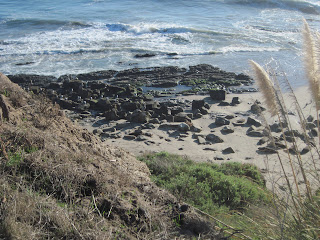Our day Friday began at the Channel Islands Visitor Center in Ventura. John had read that there was a good park movie there on the Channel Islands. It was not in our plans to go to the islands that day as it involves a boat ride to get over to the islands. A trip there would take up much of the day. I sure do have hope some day to travel over there, however! The islands and their encircling waters are home to plants and animals found nowhere else in the world. The visitor's center has a native plant garden where we could see some of those plants.
The above picture it that of a giant coreopsis. I thought my eyes were fooling me at first; those sunflowers should be blooming on the ground, not coming out of a tree trunk! The plant was at one time beaten back by grazing animals on the Channel Islands, but now that five of the eight California Channel Islands became part of our national park system (in 1980), it is blossoming abundantly. The park is one of the least visited of all the national parks because it is not easy to get to. The movie which we saw at the center, "A Treasure in the Sea", stressed the islands' feeling of solitude and richness of biologic diversity. After the movie we climbed a tower in the visitor center to view Anacapa and Santa Cruz Islands, the two Channel Islands closest to the California shore. Anacapa is 15 miles away and Santa Cruz is 21. The latter island has the highest peaks of all the islands. It also has the largest and deepest sea cave in the world.
We were encouraged by a park ranger to check out a beach north of the city of Ventura where harbor seals where staying during the winter months. Before heading out of town, however, we first visited Saint Buenaventura Mission. It was the last mission started by Father Junipero Serra in 1782. The gardens of the mission are quite beautiful, as you can see in the picture below.
Carpinteria Bluffs Nature Preserve is where we found the harbor seals. In a couple of week they will be having their babies. Currently the beach is a protected birthing habitat for the seals during the winter months.We could only look down on the seals from a bluff above them. Two high schools students were there also, it was their community service project to watch the beach for the afternoon in order to ensure that no one disturbed the seals. A docent, who later joined us, commented that if the seals feel in any way threatened on that portion of the beach they would choose another area for their pupping. While we were there we also noticed many pelicans and other shore birds hanging out with the seals. We later did find some tide pools in the preserve which were not close to the seals. The only aquatic life we found in those pools were sea anemones. We took the longer way home through the Santa Ynez Mountains, which afforded us some very stunning mountain vistas. I continue to marvel at the natural beauty of California! A view of the seals can be seen below, in their lounging positions they do look like large rocks.
Sunday, January 29, 2012
Subscribe to:
Post Comments (Atom)




No comments:
Post a Comment